#transatlantic unity
Explore tagged Tumblr posts
Text
Italian PM Calls for Reasoned Approach Amid Escalating EU-US Tariff Tensions
In a heartfelt video address to Italian American citizens, Prime Minister Giorgia Meloni emphasized the deep, unbreakable bond between Italy and the United States while calling for a measured response to the unfolding tariff dispute between the EU and the US. Speaking with emotion, Meloni expressed profound gratitude for the Italian-American community’s contributions to America’s prosperity and…
#defence strategy#EU-US relations#Giorgia Meloni#Italian exports#Italian-American relations#JD Vance#tariff war#transatlantic unity#Trump tariffs
0 notes
Text




#Diaspora connections#abstract cartography#African diaspora#migration patterns#visual storytelling#cultural mapping#Afro-futurism#ancestral roots#global Black identity#geographic abstraction#identity exploration#Black history#transatlantic heritage#artistic maps#abstract design#cultural networks#historical displacement#African legacy#creative mapping#symbolic landscapes#memory and movement#ancestral pathways#Black cartographers#visual narrative#global unity#borderless art#spatial identity#heritage mapping#Black migration#interconnected histories
1 note
·
View note
Text



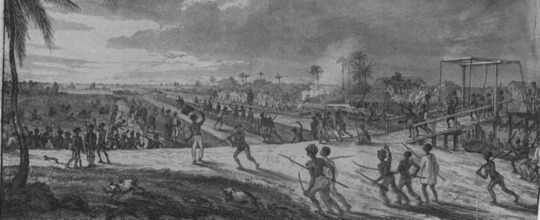
List of notable slave revolts in the Caribbean during the Transatlantic/European Slave Trade. These Slave revolts emphasise the collective struggle for liberation,
unity, and self-determination:
1. The 1638 St. Kitts Slave Revolt: Enslaved Africans resisted early attempts by European colonizers to dominate the island. This uprising showed that from the very beginning, Africans refused to accept their dehumanization and fought to retain their dignity.
2. Barbados Revolt of 1649: Africans in Barbados challenged the plantation system, laying the foundation for future resistance. This revolt demonstrated the shared struggle of African people across different colonies.
3. The 1675 Curaçao Revolt: Enslaved Africans, many of whom were from the Akan and other warrior societies in West Africa, plotted to overthrow the Dutch colonists. This revolt highlighted the persistence of African resistance traditions, even in exile.
4. Tacky’s War (1760, Jamaica) :Led by Akan warriors like Tacky, this revolt was deeply rooted in African military traditions. It was a call for liberation and unity, showcasing the resilience of African cultures under enslavement.
5. Berbice Slave Rebellion (1763, Guyana): Under Cuffy (Kofi), enslaved Africans controlled parts of Berbice for over a year. This Pan-African hero envisioned an independent African-led society in the Americas, directly challenging European colonialism.
6. Coromantee Wars (1765–1766, Jamaica): Enslaved Akan Africans led revolts against British plantation owners. The unity of African warriors in organizing these rebellions demonstrated the spirit of Pan-Africanism.
7. 1773 Grenada Revolt: Africans resisted their French and British oppressors, reflecting a Pan-African vision of collective liberation and defiance against European exploitation.
8. The First Maroon War (1728–1740, Jamaica): Maroons, descendants of escaped Africans, fought the British for autonomy. Their victory in establishing independent territories was a significant Pan-African triumph.
9. Haitian Revolution (1791–1804, Saint-Domingue): The most powerful expression of Pan-Africanism in the Caribbean, this revolution united enslaved Africans and free people of color. Leaders like Toussaint Louverture, Jean-Jacques Dessalines, and others overthrew French rule, ending slavery and creating the first Black republic.
10. Bussa’s Rebellion (1816, Barbados): Bussa, inspired by the African tradition of communal resistance, led this uprising against British slavery. It echoed Garveyite ideals of self-determination before their time.
11. Demerara Rebellion (1823, Guyana): Led by Jack Gladstone and Quamina, this revolt sought freedom for Africans in British Guiana. It reflected a broader Pan-African consciousness and the demand for dignity and justice.
12. Baptist War (1831–1832, Jamaica): Also known as the Christmas Rebellion, it was led by Samuel Sharpe, who united enslaved people under the banner of Christian and African liberation. This revolt hastened the abolition of slavery in the British Empire.
13. The Second Maroon War (1795–1796, Jamaica): Maroons resisted British incursions into their autonomy, preserving their African-rooted systems of governance and solidarity.
14. 1837 St. Lucia Revolt: Enslaved Africans rose up against British oppression. Their resistance embodied Pan-African ideals, rejecting the colonial domination of their homeland.
15. Trinidad Slave Revolt (1838): Enslaved Africans on the brink of emancipation staged a revolt, demonstrating their refusal to accept anything less than complete freedom.
16. 1733 St. John Slave Revolt (Virgin Islands): Enslaved Africans, many of whom were Akan, took control of the Danish colony for several months. Their strategic unity reflected a Pan-African ethos.
17. Leeward Maroon Wars (1730s–1740s, Antigua and Jamaica): These wars involved guerrilla tactics by escaped Africans who maintained cultural and spiritual links to their homelands.
18. Martinique Revolt (1833): Enslaved Africans rose up against French rule, signalling the unity of Black people against colonial oppressors across linguistic and cultural divides.
19. Santo Domingo Resistance (1795, Dominican Republic): Inspired by the Haitian Revolution, enslaved Africans rebelled, resisting both Spanish and French colonial systems.
#black people#black#black history#black tumblr#blacktumblr#pan africanism#black conscious#africa#black power#black empowering#slave revolts#Slave Rebellion#trans atlantic slave trade#african history#black culture#african culture#black community#caribbean history#afro caribbean culture#black liberation#black freedom#uprising#black revolution
254 notes
·
View notes
Text

Guiding Rose Pan African Education on Gorée Island
Being a guide for the remarkable group of Black women from Rose Pan African Education was an unforgettable honor. These incredible women traveled from The Netherlands, the US, Panama, Switzerland, and Ghana to connect with their shared history on Gorée Island.
As I shared the island's history, from its colonial past to the painful legacy of the transatlantic slave trade, the group listened with deep emotion. Visiting the House of Slaves, particularly the infamous "Door of No Return," was a profoundly moving experience. Many of the women wept as they stood in the same space where countless Africans were once torn from their homeland.
The strength and unity of these women reminded me of the importance of storytelling and preserving history. Their visit was a powerful reminder of Gorée Island's role in connecting past and present, pain and resilience, memory and healing.
Date: 4th of January, 2025
#Goree Island#Africa#Senegal#black history#Dakar#African Diaspora#African Tourism#Black Women Travel
64 notes
·
View notes
Text
European Commission President Ursula von der Leyen unveiled an unprecedented $840 billion plan to increase EU defense spending on March 4 as the continent continues to grapple with the dramatic changes taking place in the international security landscape amid US President Donald Trump’s new foreign policy agenda. “Europe is ready to massively boost its defense spending,” she stated in Brussels, noting that this was necessary to back Ukraine against ongoing Russian aggression and also “to address the long-term need to take on much more responsibility for our own European security.”
EU leaders are expected to discuss the proposed package at an emergency meeting later this week, marking the latest in a flurry of recent summits held to bolster European security and expand support for Ukraine. This sense of urgency reflects mounting alarm in European capitals as the Trump administration signals its intention to reduce the United States commitment to Europe and announces a pause in military assistance to Ukraine. With faith in transatlantic unity now rapidly evaporating, Europe is waking up to a new geopolitical reality and recognizing that it must now be prepared to defend itself.
Throughout Europe, there is an acute awareness that the continent is not yet fully prepared to meet the threat posed by Vladimir Putin’s revanchist Russia. Russia’s full-scale invasion of Ukraine, the largest war in Europe since World War II, is currently in its fourth year. Meanwhile, the Kremlin continues to escalate its broader hybrid war against the West. There are now growing concerns that unless Russia can be stopped in Ukraine, Moscow will seek to exploit uncertainly over the US position in order to expand its campaign against a vulnerable Europe.
In this fast-evolving geopolitical environment, European leaders must find the political resolve to translate recent statements of intent into the kind of bold policies necessary to safeguard the continent’s security. This will also require considerable powers of persuasion in order to convince complacent European audiences that security is now a priority. The good news is that on paper at least, Europe possesses the resources to assert its strength and stand alone against Russia.
The economic disparity between the European Union and Russia is particularly striking. In 2024, the combined GDP of EU member states reached $19 trillion, dwarfing Russia’s approximately $2 trillion economy. According to IMF data from February 2025, Russia does not even rank among the world’s top ten economies, trailing behind the United States, China, Germany, Japan, India, the United Kingdom, France, Italy, Canada, and Brazil. Although the Russian economy has withstood sanctions imposed in response to the invasion of Ukraine, the ongoing war has left it overextended.
In terms of population, the EU’s 449 million citizens significantly outnumber Russia’s 145 million. Moreover, Russia’s longstanding demographic crisis has worsened in recent years. Up to one million Russians are believed to have emigrated since 2022, representing the largest exodus since the Bolshevik Revolution of 1917. Estimated Russian battlefield losses in Ukraine numbering hundreds of thousands are further undermining the country’s already deteriorating demographic outlook.
Europe holds a significant edge over Russia in military spending. In 2024, EU nations collectively spent $457 billion on defense compared to Russia’s $146 billion defense budget. While Russia has moved its economy to a wartime footing and is set to continue increasing military spending, many European countries have recently committed to boosting their own defense budgets. There has long been reluctance among some NATO members to meet the alliance’s two percent target, but French President Emmanuel Macron and others are now calling on Europeans to dramatically increase annual defense spending to over three percent of GDP.
While Russia retains a strategic advantage in nuclear capabilities, the UK and France possess nuclear arsenals that can provide Europe with a credible deterrent. Europe has been steadily boosting military output since 2022, with share prices in European weapons producers surging to new highs in recent days in expectation of further investment in the continent’s defense industries. In terms of conventional military strength, the balance of power is more nuanced. Europe, including the UK, fields around 1.47 million active duty military personnel, according to Bruegel and SIPRI data from 2024. In comparison, Russia is reportedly working to expand its active duty force to 1.5 million troops.
In the realm of economic warfare, Russia faces significant constraints. Russian energy exports to Europe were once a key Kremlin tool but this leverage has significantly diminished since the onset of the Ukraine invasion. Instead, the United States has emerged as a key exporter of Liquefied Natural Gas (LNG), enabling European countries to diversify away from Russia. While Russian energy exports to Europe continue, the continent increasingly relies on US, Norwegian, and Algerian gas.
Given the overall balance of power between Europe and Russia, European leaders have ample reason to adopt a more resolute stance. By leveraging its economic strength, demographic advantage, and military potential, Europe can confidently counter Putin’s imperial ambitions and provide Ukraine with the support it needs to resist Russia’s invasion. The onus now is on European leaders to transform these strategic advantages into effective policies and actions. With sufficient political will, Europe can defend itself and back Ukraine against Russia.
10 notes
·
View notes
Text
Donald Trump will never win the Nobel Peace prize. But he should be a strong contender for the Charlemagne prize — which is awarded each year to the person who has made the greatest contribution to European unity. The US president has courted Russia, undermined faith in the Nato alliance, threatened the EU with tariffs and boosted the far right in Europe. All this has had a galvanising effect on the EU. Fundamental steps towards greater European unity — stalled for decades — are now under way. There are three key areas to watch. The first is European defence; the second is joint European debt; the third is repairing the breach between the UK and the EU. Dramatic swings in European public opinion underpin these developments. A poll last week showed that 78 per cent of British people regard Trump as a threat to the UK. Some 74 per cent of Germans and 69 per cent of the French agree. In another poll, France was rated as a “reliable partner” by 85 per cent of Germans and Britain scored 78 per cent — the US is down at 16 per cent. Many European leaders agree that Trump’s America is now a threat, though few will say it out loud for diplomatic reasons. They are also uncomfortably aware of how the transatlantic alliance, now in its eighth decade, has made them highly dependent on American military support. This is not just a question of money. The really dangerous dependencies are on US technology and weaponry. The Europeans can see how much trouble the Ukrainians are in after the Trump administration’s decision to cut off flows of intelligence and weaponry. So they are pursuing a two-track policy. They need to delay the severance of American military support to Europe for as long as possible, while preparing for that moment as fast as possible. That was the logic behind last week’s decision to allow the European Commission to raise €150bn to spend on the EU defence industry. The new spending is likely to be concentrated on areas where European countries are particularly dependent on America, such as air defence. The issuance of common European debt is not just a way of raising money for defence. It also offers the chance to build up the euro as an alternative to the dollar as a global reserve currency. The capriciousness of the Trump administration means that there is a considerable global appetite for an alternative to US Treasuries as a safe asset. The taboo against common European debt is traditionally strong in frugal Germany. It was partially broken during the pandemic. Now it is likely to be swept away. Friedrich Merz, who will be Germany’s next chancellor, is also moving to exempt national spending on defence and infrastructure from his country’s constitutional limits on deficit spending. Its past fiscal prudence means that Germany has much more space to borrow than heavily indebted France or Britain.
5 notes
·
View notes
Text
Significantly, the forthcoming chancellor put Donald Trump's America on a par with Russia - widely viewed here as a security threat to Europe more broadly. "We are under such massive pressure from two sides that my absolute priority now really is to create unity in Europe," Merz said. -- New German Leader Signals Seismic Shift in Transatlantic Relations.
#germany#trump#euro-american relations#nato#German elections#Friedrich Merz#fall of empire#US empire
5 notes
·
View notes
Text
Voice Actor Casting!
Black Jack PS1 Style De-make

Source material (scene) at the bottom of this post, below the cut!
Application Deadline: 1/1/2025
Roles: 0/2 (unpaid)
Looking for: Amateur to experienced voice actors with crisp audio, feel free to audition just for the sake of it! No prior knowledge of source material necessary.
Length: 1:00- 2:00 minutes
Project Overview: A Playstation 1 style cutscene adaptation of pages 122-129 of volume 7 of the manga Black Jack. It’ll feature pixelated, low-poly graphics akin to games like Metal Gear Solid and Silent Hill 2 and will have a bitcrushed sound to it. It’ll be made on blender and unity for my Digital Art portfolio at Penn State!
Here are some helpful links:
Volume 7 of Black Jack on manga reader (unofficial publication, link my be dubious): https://mangareader.to/read/black-jack-233/en/volume-7
Black Jack 90s OVA & Movie: https://youtube.com/playlist?list=PLGNb1OdgI2gzcXyybifvZyXzwB08qiyHS&si=v3TZ3Ry_599Gck_g
Style i’m aiming to achieve done by another creator: https://youtube.com/shorts/XsbVGScqSso?si=ji7ZAdNdtfn64iMp

Roles
Black Jack/Kuroo Hazama
Description: Lead Role. Clean, crisp audio (unless, see desc.). Lines taken from pages 122-129 of Black Jack, Volume 7.
Dr. Black Jack is the world’s greatest surgeon with a mysterious past, this scene is when his backstory is finally revealed. It reveals his motives as to why he hoards money and why a lot of his schemes all come with some kind of catch.
I’m looking for someone with a deeper voice, but one that is smooth as well. Not gravelly, not too deep like batman, and not like the stereotypical kinda of john smith video game type grunt either. Black Jack’s voice is deeper, but not too deep, if that makes any sense. I’m also very fond of his Japanese VA, Akio Otsuka, but of the english dubs I’ve seen of Black Jack— no one seems to get his voice right or make it sound like Otsuka. So for this role, I recommend looking on youtube for clips/episodes of the 90’s OVA to hear his voice. A suggestion to make your audition stand out: this manga did take place in 1973, so if you want to throw in a very slight transatlantic or otherwise “old timey” accent, be my guest. But above all else I feel like he should like a professional, almost have a narratorial type of voice.
Sample audition lines (taken from source material):
“For that faithful day, he started to hoard money. What a thing money is— it can even absolve murder.”
“Now answer me! You let yourself be bribed by the official who wanted to sell that land and removed the “do not enter” signs! Wasn’t it you?! Huh?! Say it! You did it with those hands!”
“She had no arms, or legs, and lay there voiceless like a doll, with a tube in her throat supplying her oxygen and nutrients. A large scar remained on the boy’s face and his hair turned white with fear. But his mother! She didn’t even look human.”
Unnamed Bribed Government Official
Description: This character is responsible for the negligence that lead to what happened with Black Jack and his mother when he was a child. He was bribed in order to hasten up the clean up of land mines and is now facing judgment for it. He should sound cowardly and worried for what might happen to him. He has very few lines, what’s in the audition lines is legit all he says. This manga did take place in 1973, so if you want to throw in a transatlantic accent too or an old timey noise effect over your audio, be my guest.
Sample audition lines (taken from source material):
“Y… Yes. I received 100,000 yen from Mr. Gouger, the housing director, and took away all the warning signs.”
“H…Help…”
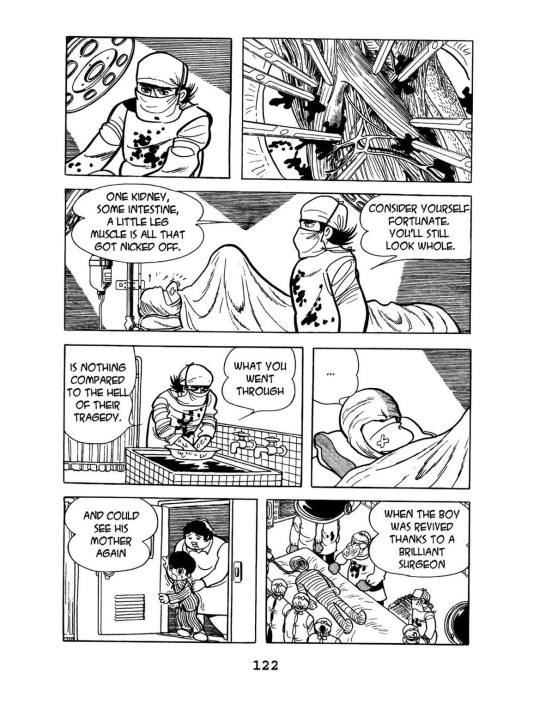

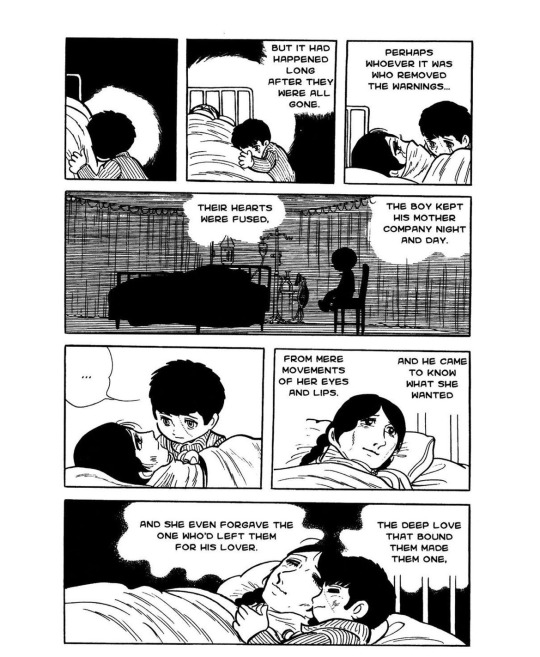
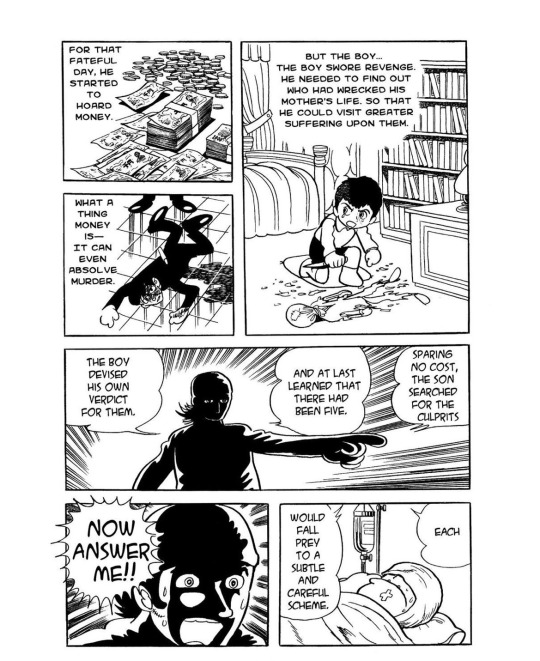


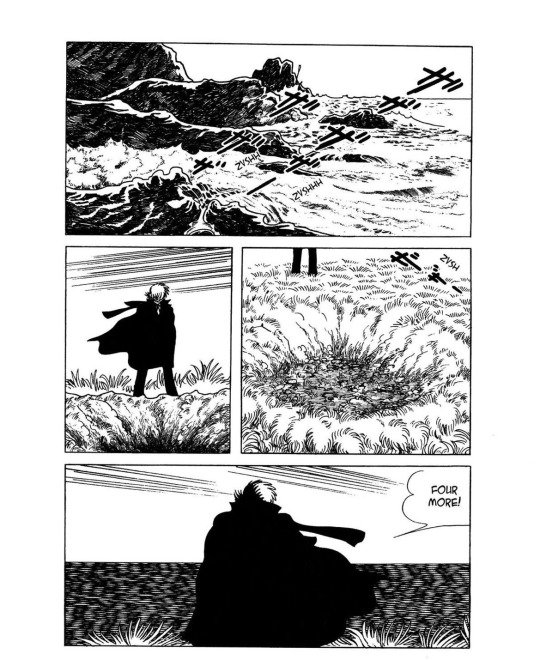

#art#artist#fanart#anime#manga#black jack: the movie#black jack manga#dr black jack#black jack tezuka#osamu tezuka#tezuka star system#tezuka osamu#fandub#demake#playstation#ps1#playstation 1#reanimated#animation#3d animation#blender#unity#voice acting#voiceover#casting#casting call#audition
6 notes
·
View notes
Text
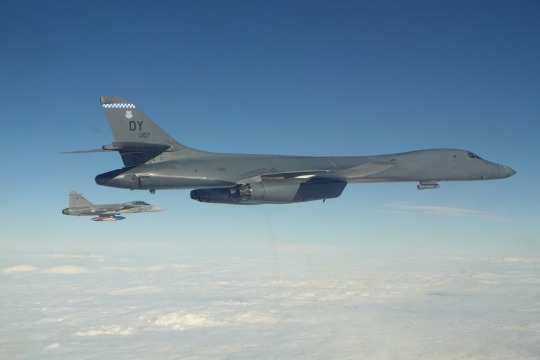
IMAGES: B-1B bombers conduct mission with Gripens from three countries during deployment in Europe
Fernando Valduga By Fernando Valduga 10/27/2023 - 4:00 p.m. in Military
U.S. Air Force B-1B bombers from Dyess Air Base, Texas, currently deployed to RAF Fairford, United Kingdom, undertook a comprehensive Bomber Task Force mission in Eastern Europe and also flew alongside Gripens fighters from three nations.
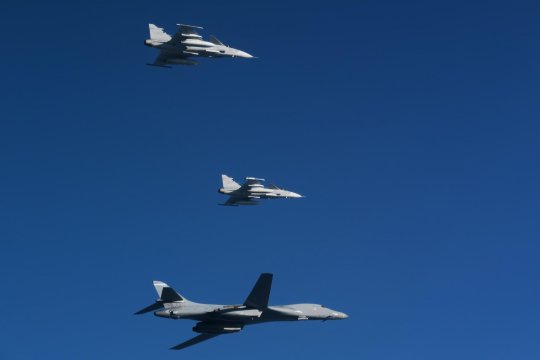
The bombers have been collaborating closely with fighters of NATO allies, the Czech Republic and Hungary, over Eastern Europe since October 26, 2023.

A B-1 also carried out a flight over Romania's Mihail Kogalniceanu "MK" Air Base, meaning unwavering support. The overflight is a powerful demonstration of shared values and mutual alliance, contributing to the strengthening of NATO unity.

"The current mission of the Bomber Task Force serves as another testimony of our unwavering dedication to Allies and partners, showing our collective ability to strategize, execute and synchronize perfectly together," said General James Hecker's commander, U.S. Air Forces in Europe, Air Forces in Africa and NATO's Allied Air Command.
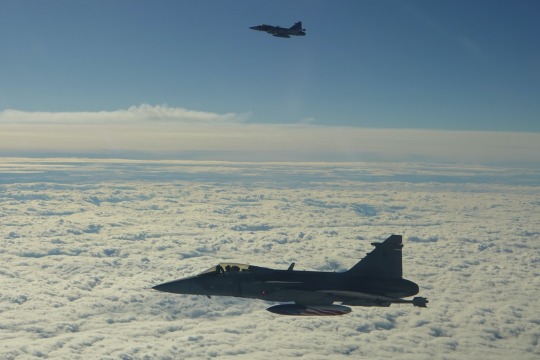
The B-1 Lancers successfully carried out the long-planned mission, showing the broad global capabilities of these aircraft. The collaborative mission with NATO countries and partners highlights the collective unity of the Alliance, while underlining its commitment to maintaining peace in the region.
The missions of the bomber task force show the ability of the U.S. to efficiently lead and supervise its fleet of bombers for global missions, further solidifying the commitment to the NATO and U.S. National Defense Strategy.
Tags: Military AviationB-1B LancerFlygvapnet - Swedish Air ForceJAS39 GripenUSAF - United States Air Force / U.S. Air Force
Sharing
tweet
Fernando Valduga
Fernando Valduga
Aviation photographer and pilot since 1992, has participated in several events and air operations, such as Cruzex, AirVenture, Dayton Airshow and FIDAE. He has work published in specialized aviation magazines in Brazil and abroad. Uses Canon equipment during his photographic work in the world of aviation.
Related news
HELICOPTERS
Norway acquires six MH-60R Seahawk helicopters
27/10/2023 - 14:00
MILITARY
Ukrainian pilots start training in F-16 based in Arizona
27/10/2023 - 13:00
MILITARY
B-52 bomber supports NATO Steadfast Noon exercise on transatlantic mission
27/10/2023 - 11:00
MILITARY
Boeing reports increased loss with the new Air Force One program
27/10/2023 - 08:20
BRAZILIAN AIR FORCE
IMAGES: Temporal damages several T-27 Tucano aircraft in the Air Force Academy
10/26/2023 - 10:10 PM
MILITARY
IMAGES: Portugal performs first force projection with new KC-390 transport plane
10/26/2023 - 7:51 PM
16 notes
·
View notes
Text
20241106 Gabriel Attal faces it

Bonjour à toutes et à tous! It's not an exaggeration to say that politics has fallen into chaos. While the left engaged in blame games and the right wing rejoiced over their new transatlantic partner as Trump waltzed back to the White House (this editor almost wanted to skip the update today entirely amid this), Gabriel Attal calmly and methodically welcomed his guests to the organization he established to... combat bullying.
So Let's Face It
As I mentioned yesterday, Attal is launching his anti-bullying foundation “Faire Face”. The event, which took place at the Philanthro-Lab in Paris, brought together tech giants like Meta, alongside Education Minister Anne Genetet. “Faire Face”, which translates to “Face It”, aims to tackle the pervasive issue of school bullying, which affects an estimated two students per classroom in France.


Attal, the former Prime Minister and Minister of Education, co-founded “Faire Face” with Béatrice Le Blay, whose son tragically took his own life due to bullying, and Elian Potier, a former victim himself. They’re determined to use their platform to offer legal and psychological support to families affected by bullying. The foundation also plans to lobby for systemic change, a key concern for Attal, who believes that the current response to bullying is insufficient.
The launch coincided with the National Day Against School Bullying, marked annually on November 7th in France. Attal’s team has been careful to position “Faire Face” as a collaborative force, emphasizing that the foundation will not compete with existing anti-bullying organisations, but rather seeks to consolidate and amplify their work.
More on the party...
But Attal’s busy week doesn’t end there! He’s also making headlines for his political ambitions. We know that he's probably going to inherent the presidential party Renaissance. Regarding this new page, some in his entourage have jokingly remarked that Attal is "off to a good start!”, while others are pointing to his ability to “guarantee the political unity of his political family”. His deft handling of the transition within the EPR group, where he reportedly reached an “arrangement” with Élisabeth Borne (who was also eyeing the leadership role), suggests that he might just pull this off...or so we hope.
And... Future grilling
But let’s not forget, Attal’s political manoeuvring comes at a particularly fraught time for the French government. The public deficit is set to balloon to 6.1% of GDP this year, significantly exceeding initial projections. And who’s being blamed for this budgetary mess? Bruno Le Maire, the former Minister of Economy and Finance, who held the reins at Bercy for a whopping seven years He’s been accused of playing fast and loose with the numbers, particularly by those on the right.
But Le Maire has defended his record, pointing to the massive support packages deployed during the pandemic and subsequent crises, as well as disappointing tax revenues. He'll have a chance to reiterate his defence during a Senate hearing on Thursday, as part of a fact-finding mission investigating the public finance debacle. Attal himself, along with former Prime Minister Élisabeth Borne, will also be grilled by senators in the coming days.
Speaking of grilling, remember that Attal is scheduled to be questioned by the National Assembly on November 12th regarding potential abuse of power during his time as caretaking Prime Minister. Future hearings regarding the topic, if any, could also see the reappearance of his ex, Stephane Sejourne, then Minister of Europe and Foreign Affairs. Get ready for a reunion, and buckle your seatbelt.
4 notes
·
View notes
Text
frankly, in this politically polarized time, in an effort to bring about national unity, i think we, as americans, should band together to collectively adopt the transatlantic accent
#this comes to you from me watching the philadelphia story#i don't care if it's a fake accent–it sounds better than literally anything we have going on rn#text
6 notes
·
View notes
Text
Inter Milan x Nike x NFL Game 2025 Football Jersey

Link Product: https://inspirdg.com/product/inter-milan-x-nike-x-nfl-game-2025-football-jersey/
A Global Power Play in Fabric: The Inter Milan x Nike x NFL Game 2025 Football Jersey
When Soccer Meets Gridiron: An Unforgettable Collision of Cultures
The Inter Milan x Nike x NFL Game 2025 Football Jersey is not just a garment—it’s a groundbreaking cultural crossover, a symbol of unity between two of the most dominant forces in global sport. In this audacious and visionary collaboration, American football’s explosive energy meets European football’s regal tradition, all captured under the elite craftsmanship of Nike. The result? A jersey that does far more than look good—it redefines what it means to represent international athletic excellence.
Inter Milan, a club steeped in over a century of history and style, brings its striking visual identity and deep emotional resonance to a new arena—the NFL gridiron. The collaboration speaks to a new generation of fans who no longer see sports as separate silos, but as a vibrant, interconnected universe. This jersey is a bold handshake between continents, and every thread is woven with meaning.
A Black Canvas of Prestige and Performance
The foundation of this masterpiece is its deep matte black base—a hue chosen not just for its sleek minimalism but for its symbolic depth. Black represents control, authority, and timeless fashion. For Inter Milan, it’s a return to elegance. For the NFL, it’s a nod to toughness and grit. And for the streetwear world, it’s a staple of dominance.
The front and back showcase the word “INTER” in sharp gold lettering, a visual crown that sits with poise atop the jersey. It’s proud, but never boastful. Below it sits the unmistakable “00” jersey number, designed in a modern block font with bold blue-and-gold trim, echoing Inter Milan’s iconic color palette. This is not just visual decoration—it’s a fusion of legacy and evolution. The small Inter crest embedded inside each zero is a delightful detail, rewarding the true fan who knows where to look.
Details That Make Legends
One of the most exceptional aspects of this jersey is its attention to micro-details that amplify its storytelling power. On each sleeve, the Inter Milan crest is proudly displayed, not just as a badge of honor, but as a symbol of global respect. The right shoulder also features the instantly recognizable Nike Swoosh, while the NFL shield sits perfectly at the center neckline, representing the transatlantic union of sporting powerhouses.
Even the typography has been carefully considered. The gold font is futuristic yet grounded, strong yet stylish. It bridges fashion with functionality. The V-neck collar and athletic tailoring ensure this jersey doesn’t just look sharp—it performs, fitting seamlessly into both on-field action and off-field swagger.
The star placed above the crest—a signature detail celebrating Inter’s legacy of triumph—adds an extra layer of sophistication. It’s subtle, but it elevates the visual hierarchy, reminding fans and players alike that this jersey carries the weight of championship DNA.
A Modern Icon for the Global Game
What makes this jersey revolutionary is its cultural boldness. It’s not every day that a European football giant like Inter Milan steps into the world of the NFL. This design doesn’t shy away from the challenge—it embraces the chaos of innovation and turns it into confidence. It's futuristic in concept but rooted in classicism. The message is clear: boundaries no longer exist.
This jersey is more than an intersection of football codes—it’s a blueprint for the future of fanwear. Imagine a Milanese street kid and an Ohio quarterback both rocking the same piece. This is not fantasy. It’s fashion reality. It’s wearable diplomacy, proving that sport transcends language and borders when it’s expressed through art.
Conclusion: A Cross-Continental Masterpiece of Form and Identity
The Inter Milan x Nike x NFL Game 2025 Football Jersey is a triumph of collaboration. It pays tribute to two of the most beloved sports on Earth, while delivering a bold, modern silhouette that redefines what it means to wear your team with pride. This isn’t a jersey built for one field—it’s a symbol for every stage, every fan, and every dreamer who knows the beauty of a goal and the thunder of a touchdown.
In this jersey, the world becomes smaller. The culture becomes richer. And the fashion? It becomes legendary.
0 notes
Text

Overemphasis on Assimilation into Western Culture: A Garveyite Perspective
Introduction: The Psychological Chains of Western Assimilation
The obsession with assimilating into Western culture has been one of the most damaging consequences of colonialism, slavery, and white supremacy for the Black world. Instead of embracing African cultural, economic, and spiritual traditions, many Black people have been conditioned to see Westernization as the only path to progress, respectability, and success.
From a Garveyite perspective, this overemphasis on assimilation is not just a personal choice—it is the result of a deliberate strategy to disconnect Black people from their roots, weaken Pan-African unity, and ensure permanent psychological and economic dependency on Western nations.
If Black people do not reject the myth that Westernization equals progress, they will continue to be mentally, economically, and politically enslaved—even without physical chains.
1. The Historical Roots of Forced Western Assimilation
A. The Role of Slavery in Enforcing Western Cultural Norms
During the Transatlantic Slave Trade, enslaved Africans were:
They are stripped of their names and given European names to erase their African identity.
Forced to abandon their languages, replacing them with European tongues.
Converted to Christianity, while their traditional African spiritual systems were demonized.
Taught to imitate European customs, with severe punishments for embracing African traditions.
Example: Enslaved Africans in the Americas were banned from drumming, speaking their languages, or practising African rituals, because European enslavers knew that cultural continuity would fuel rebellion and resistance.
Key Takeaway: The foundation of Western assimilation was built on control—Black people were forced to abandon their culture to make them easier to dominate.
B. The Colonial Education System and the Destruction of African Identity
European colonizers established Western-style schools in Africa and the Caribbean, where Black children were taught that:
African history began with European “discovery” and colonization.
European languages, customs, and political systems were superior.
Success meant adopting Western dress, behaviour, and beliefs.
African intellectuals who challenged colonial education were often marginalized, imprisoned, or assassinated.
Example: Many African nations still prioritize English, French, or Portuguese over indigenous languages, proving that colonial education still dictates cultural norms.
Key Takeaway: The education system was used as a tool of cultural genocide—teaching Black children to reject their own identity in favour of European validation.
2. The Modern Consequences of Overassimilating into Western Culture
A. The Worship of European Beauty Standards
One of the most destructive effects of Western assimilation is the widespread rejection of African beauty.
Many Black people internalize European beauty ideals, leading to:
Skin bleaching – A multi-billion dollar industry fueled by self-hatred.
Hair straightening & rejection of natural hair – Many Black women and men feel pressured to conform to Eurocentric hair standards.
Preference for European facial features – Thin noses, lighter skin, and “mixed-race” aesthetics are glorified over African features.
Example: In many African and Caribbean countries, lighter-skinned individuals are given better job opportunities, proving that colonial beauty standards still control access to success.
Key Takeaway: When Black people reject their own beauty, they subconsciously accept the idea that whiteness is superior.
B. The Dependence on Western Economic Systems
Black nations and individuals are conditioned to believe that true success comes from Western capitalist and neoliberal models, leading to:
Overreliance on European and American corporations rather than developing African-owned businesses.
Brain drain – African and Caribbean nations losing their most talented people to Europe and America.
Import dependency – Many African nations produce raw materials but import finished goods from the West, keeping them economically dependent.
Example: Africa produces over 70% of the world’s cocoa, yet European companies like Nestlé and Hershey make billions selling chocolate, while African economies remain poor.
Key Takeaway: True economic freedom will never come from Western systems—it will come from African self-sufficiency.
C. The Political Submission to Western Powers
Many Black nations seek validation from Western governments, rather than asserting their own sovereignty, leading to:
Neocolonialism – African and Caribbean leaders depend on Western aid and approval instead of leading independently.
Mimicking Western political structures – African nations copy European governance models instead of developing African-centered political systems.
Disrespect for African traditional governance – Indigenous leadership systems that worked for centuries are dismissed as “backwards” in favour of European democracy.
Example: Many African nations still use European constitutions and laws, long after gaining independence.
Key Takeaway: African nations must rule according to their own traditions and values—not copy Western systems that were designed to exploit them.
3. The Psychological Effects of Overassimilating into Western Culture
A. The Mental Slavery of Seeking White Validation
Many Black individuals and leaders feel the need to:
Prove their intelligence to white society – Constantly seeking white approval rather than building Black institutions.
Distance themselves from African identity – Some Black people feel ashamed to be associated with Africa.
Look down on “too Black” behaviours – Some Black people see African culture, accents, and names as “ghetto” or “uncivilized.”
Example: Many Black professionals feel the need to code-switch or “act white” to be accepted in corporate spaces.
Key Takeaway: True freedom means living for your people, not adjusting yourself to fit white society’s expectations.
B. The Weakening of Black Unity and Pan-Africanism
Western assimilation divides the Black community by creating:
Class divisions – Educated and Westernized Black people often see themselves as superior to “uneducated” or “rural” Africans.
Religious divisions – Many Black Christians and Muslims reject African spiritual practices as “pagan” or “devilish.”
Nationality over race – Many Black people identify more with their colonizer’s nationality than with the global Black community.
Example: Some Black immigrants look down on Black Americans, and some Black Americans reject African immigrants, rather than seeing their shared struggle.
Key Takeaway: When Black people are divided, they are easier to control—this is why unity must be prioritized over Western acceptance.
4. The Garveyite Solution: Rejecting Western Assimilation and Reclaiming Black Identity
A. Embracing African Cultural and Spiritual Traditions
Black people must reclaim African names, languages, and traditions to restore their identity.
African spiritual systems must be respected and revived, rather than being dismissed as “evil.”
Black artists, writers, and filmmakers must elevate African culture over Eurocentric perspectives.
Example: Instead of celebrating European holidays like Christmas, Black people should embrace African traditions like Kwanzaa, Odwira, or Ifá festivals.
Key Takeaway: A people without their own culture are forever mentally enslaved.
B. Building Black Economic and Political Power
Black nations must prioritize intra-African trade over dependence on the West.
Black communities must fund Black businesses, banks, and institutions instead of relying on white-owned corporations.
Black leaders must reject foreign aid and IMF loans, developing self-sustaining African economic models.
Example: African nations should focus on Pan-African trade alliances, rather than competing for Western approval.
Key Takeaway: Only an economically independent Black world can resist white domination.
Conclusion: Will We Continue Assimilating, or Will We Build Our Own Future?
Marcus Garvey said:
"Be Black, buy Black, think Black, and all else will take care of itself."
Will Black people continue seeking Western validation, or reclaim their African identity?
Will we assimilate into systems designed to oppress us, or create our own institutions?
The Choice is Ours. The Time is Now.
#black history#black people#blacktumblr#black tumblr#pan africanism#black conscious#africa#black#black power#black empowering#Garveyism RejectAssimilation PanAfricanism ReclaimBlackIdentity BlackExcellence#blog#Marcus Garvey#garveyism#Garveyite
117 notes
·
View notes
Text
A New Chapter for NATO: How Mark Rutte Could Redefine Global Security
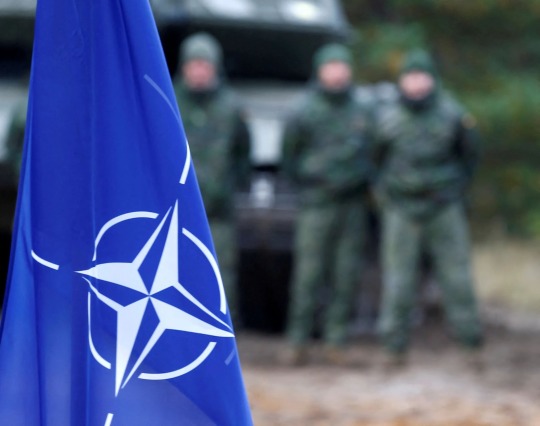
As Mark Rutte prepares to take over the role of NATO Secretary General, the world is watching with curiosity — and high expectations. Known for his calm, no-nonsense approach as Dutch Prime Minister, Rutte now steps onto a much larger stage at a time when the need for unity, strategy, and leadership has never been greater.
With global tensions rising, cyberattacks growing more frequent, and traditional diplomacy facing new challenges, Rutte is not just inheriting a position — he’s taking on one of the toughest leadership jobs in the world. So what can we expect?
Let’s take a look at the man behind the suit, his goals for the alliance, and how his leadership could shape NATO’s role in the years to come.
🧭 Why Mark Rutte?
Rutte’s time as Dutch Prime Minister showed the world a leader who:
Listens more than he talks
Finds compromise instead of creating conflict
Leads with steadiness, not shock value
That quiet strength might be exactly what NATO needs right now. The alliance is bigger than ever, with 32 member nations and more likely to join. But with more members comes more complexity — and more need for someone who can manage disagreement without division.
🌍 A New Kind of Threat, A New Kind of Response
Today’s biggest security threats often don’t come with uniforms or flags. They come through screens, data breaches, and misinformation.
That’s why Rutte is expected to focus on:
Cybersecurity coordination across NATO countries
Stronger defense against online misinformation
Working with tech companies to stop digital threats before they spread
These steps are especially crucial as more attacks are happening online than ever before. In this digital age, even a small vulnerability can turn into a massive risk.
🤝 Balancing Old Friends and New Voices
NATO has always relied on strong ties between the U.S. and Europe. But maintaining that relationship, while also supporting the needs of newer members, is a tricky balance.
Rutte is likely to:
Keep transatlantic communication smooth and respectful
Make sure smaller nations feel heard, not just the big powers
Encourage fair contributions from all members — in money, equipment, and action
This helps NATO function like a real team, not just a group of separate players.
🛡️ Ukraine: The Test of NATO’s Resolve
The war in Ukraine has become more than a regional issue — it’s a symbol of how NATO responds to aggression. Under Rutte’s leadership, the alliance is expected to:
Continue providing military and humanitarian aid
Strengthen defenses in countries close to Russia
Stay united in standing against any threats to sovereignty
This isn’t just about protecting one country. It’s about showing that international partnerships like NATO still mean something.
🚀 Planning for the Long-Term, Not Just the Headlines
Rutte isn’t known for grand speeches. Instead, he focuses on practical solutions — something NATO can benefit from.
His long-term vision may include:
Using artificial intelligence and advanced data to improve defense strategies
Tackling climate-related instability as a security risk
Building deeper cooperation with other global organizations
In short, he’s thinking ahead — not just about the next summit, but the next decade.
🗣️ Making NATO More Understandable
Let’s be honest: most people don’t really know what NATO does. Rutte could help change that by:
Speaking in simple, clear language
Explaining how NATO protects everyday people — not just governments
Bringing more transparency to how decisions are made
When citizens understand NATO’s purpose, public trust grows. And in democracies, that trust is essential.
🌟 The Bigger Picture
So what does all of this add up to?
Mark Rutte’s leadership could bring:
A more modern, flexible alliance
Better communication between nations
A stronger ability to respond to both military and digital threats
He’s not trying to reinvent NATO — just make it smarter, more agile, and better prepared for what’s ahead.
Here’s what makes his approach promising:
He leads with logic, not ego
He listens to all sides before acting
He understands both the power of diplomacy and the need for strength
The world doesn’t need more dramatic leaders right now. It needs effective ones. And Mark Rutte may be exactly the kind of calm, capable voice that NATO — and the world — can rely on.
As the alliance grows, and as global dynamics shift, he’ll be leading at a time of deep transformation. But if his past is any indication, he’s ready.
0 notes
Text
Orbán threatens to mess with Ukraine aid to help Trump
Hungarian Prime Minister Viktor Orbán is preparing to serve up a major policy gift for his best friend across the Atlantic, former United States President Donald Trump.
He’s concocted a way to let Trump, if he successfully makes it to the White House for a second term come November, wriggle out of a $50 billion loan the U.S., the European Union and leaders of the G7 offered to Ukraine to back its fight for survival against Russia. That would let Trump off the hook, allowing him to tell Republican voters that, if elected, he won’t give Ukraine another cent.
Hungary says it won’t consent to a change in rules that would allow Washington to play a major role in the loan until after the U.S. election.
The loan would be repaid entirely using the windfall profits generated by over $250 billion of Russian assets that were immobilized across Western countries after Vladimir Putin’s invasion of Ukraine in February 2022. Europe has more skin in the game as it holds most of the funds.
And timing is everything. Washington insists that the EU needs to extend the sanctions renewal timeframe to at least 36 months. Under current rules, the EU’s sanctions come up for renewal every six months, which increases the likelihood of a single country unfreezing the assets — which would force national governments to tap into taxpayers’ money to repay the loan.
While every other leader is in favor of extending the sanctions rollover period to 36 months as requested by the U.S., Orbán refuses. According to the EU’s own rules, all 27 member countries need to approve any changes to the sanctions rules.
Ukraine urgently needs fresh funding from its Western allies to keep its state running and prepare for what is expected to be a brutal winter as Russia targets the war-torn country’s energy infrastructure.
And now, thanks to Orbán, the U.S. is unlikely to participate substantially. Still, Europe is likely to go ahead anyway.
“If we don’t work this out [by extending the sanctions duration] it will cost the EU — including Hungary — more money,” said one EU diplomat, who, like others quoted, was granted anonymity to speak openly about the matter.
Costs for European countries — including Hungary — would be higher than if the U.S. was on board.
However, for Orbán that’s a small price to pay. The upside for him is that he would be buying much-needed goodwill from his Republican friend.
“They [Hungary] don’t care if Europe has to pay more. It’s about helping Trump,” said a second EU diplomat.
If Brussels and Washington jointly underwrite the €35 billion loan, a reelected Trump would be tied to servicing it for years. But if the loan is approved without the U.S., he would have no such obligation.
Orbán’s blocking of the loan is the latest example of alignment between Trump and the Hungarian prime minister, who met as recently as July at Mar-a-Lago.
Speaking to journalists in Brussels, Orbán said he would be popping “several bottles of champagne” if Trump prevails over Kamala Harris in November.
The two already appear to be marching in lockstep when it comes to Ukraine.
Orbán digs in
What seems like a technical quibble is a critical consideration for Washington — and could be enough to break transatlantic unity on Ukraine support, at least on the financial front.
As Orbán threatens to use his veto in Brussels, the U.S. signaled that it is considering participating in the loan — albeit with a significantly lower amount — even if the EU cannot prolong its sanctions period, a third EU diplomat and a European Commission official said.
One of the options involves Washington contributing $5 billion, which roughly equals the amount of Russian assets that it holds domestically — and would still leave Europe footing the lion’s share of the bill.
The Commission official believes that the U.S. does not want to arrive “empty-handed” at a meeting of G7 finance ministers in Washington at the end of October that will likely decide the fine print of the $50 billion loan.
Perhaps more significantly, Japan recently signaled that it might pull out of the loan if the U.S. does not take part.
For the time being, all eyes are on the summit of EU leaders in Brussels this week.
If Hungary refuses to budge on the sanctions duration, the EU is likely to finalize the loan on its own terms because its budget rules make it much easier to get the payment approved by national capitals before year-end.
The EU is fast-tracking legislation to pay up to €35 billion to Ukraine, which covers the U.S. share of the loan and is set to be finalized by the end of October.
But penny-pinching governments in the EU are reluctant to increase their contribution to cover the shortfall from the U.S.
“We are putting pressure, but so far Orbán is not caving,” said the first EU diplomat.
“It’s just a game of chicken.”
8 notes
·
View notes